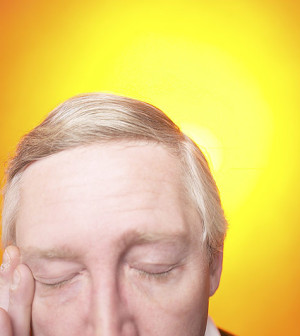- Double Mastectomy May Offer No Survival Benefit to Women With Breast Cancer
- Toxic Lead Found in Cinnamon Product, FDA Says
- Certain Abbott Blood Sugar Monitors May Give Incorrect Readings
- Athletes Can Expect High Ozone, Pollen Counts for Paris Olympics
- Fake Oxycontin Pills Widespread and Potentially Deadly: Report
- Shingles Vaccine Could Lower Dementia Risk
- Your Odds for Accidental Gun Death Rise Greatly in Certain States
- Kids From Poorer Families Less Likely to Survive Cancer
- Tough Workouts Won’t Trigger Cardiac Arrest in Folks With Long QT Syndrome
- At-Home Colon Cancer Test Can Save Lives
Obesity May Increase Migraine Odds


WEDNESDAY, Sept. 11Obese people may be at higher risk for episodic migraines, a new study suggests.
Episodic migraines — the more common type of migraine — occur 14 days or fewer per month, while chronic migraines occur at least 15 days per month.
Migraines involve intense pulsing or throbbing pain in one area of the head, according to the American Academy of Neurology. Symptoms can include nausea, vomiting and sensitivity to light and sound. Migraines affect more than 10 percent of the population.
In the study of more than 3,800 adults, those with a high body-mass index (BMI) — a measure of body fat determined using height and weight — were 81 percent more likely to have episodic migraines than those with a lower BMI. This was particularly true among women, whites and those under the age of 50.
The cross-sectional study doesn’t prove that obesity causes episodic migraines, but it does demonstrate that people who are obese have an increased risk of having more of them, even low-frequency ones, said lead author Dr. Barbara Lee Peterlin, director of headache research at Johns Hopkins University School of Medicine, in Baltimore.
“These results suggest that doctors should promote healthy lifestyle choices for diet and exercise in people with episodic migraine,” Peterlin said in a statement. “More research is needed to evaluate whether weight-loss programs can be helpful in overweight and obese people with episodic migraine.”
The study was published in the Sept. 11 issue of the journal Neurology. The researchers also presented the findings in June at the International Headache Congress in Boston.
Dr. Gretchen Tietjen, director of the headache treatment and research program at the University of Toledo, in Ohio, said she found the findings interesting because previous studies had looked for connections between obesity and chronic migraines.
“That the researchers were able to show an association between obesity and episodic migraine lends more credence to some of the earlier studies that found similar things,” she said.
She pointed out, however, that it still isn’t known which came first — the obesity or the migraine. There are many possible scenarios, Tietjen said. “Maybe the person had the migraines first and then started taking medications like amitriptyline or valproic acid,” she said. “Those medications are associated with weight gain.”
The possible connection between obesity and migraines is still under debate. One theory supporting the link centers on inflammatory substances from fat tissue (adipose) that are released into the system, Tietjen said.
Premenopausal women have more total adipose tissue in general than men, and women have more superficial and less deep adipose tissue, Peterlin said. But after menopause, adipose tissue is more similar between the two sexes.
Adipose tissue secretes different inflammatory proteins based on how much tissue there is and where it is located. Since younger women and obese people have more adipose tissue, this could, at least in part, explain why they get more headaches.
On the other hand, Peterlin also suggested that a possible connection may be related to the brain. “Previous imaging data in migraine patients have shown activation of the hypothalamus, a part of the brain that controls the drive to feed,” she said. Alternatively, it could be that people who have migraines may be more inclined to behaviors associated with weight gain, such as being less active.
Would losing weight mean migraines will decrease in frequency? Although weight loss is generally encouraged for people who are obese, that won’t necessarily result in migraine relief, Peterlin and Tietjen said.
At least two small studies have evaluated migraines in people who were obese and underwent bariatric surgery to lose weight, Peterlin said. Although these studies did find that some patients experienced fewer headaches, the studies were small and more research needs to be done to see if this is consistent.
It’s possible that the lifestyle changes needed for weight loss cut the migraine frequency, rather than the weight loss itself, the experts said. People who eliminate processed foods, high-calorie foods and alcohol — all of which can be migraine triggers — could end up experiencing fewer headaches.
Unfortunately, the opposite could also be true if dieters introduce new foods that are migraine triggers. Some people may develop migraines when they consume certain sugar substitutes, for example. There also is limited data suggesting that people with severe obesity who exercise may have fewer migraines, Peterlin said.
“Our data and previous research serve as a call to researchers in the headache field to identify safe and appropriate treatment options for obese [people with] episodic migraines of all classifications and not just those who qualify for [weight-loss] surgery,” she said.
Peterlin also suggested that physicians, in addition to providing lifestyle education to their obese patients with episodic migraines, take into account the weight-gain or weight-loss effect that migraine medications may have on their patients.
More information
Find out more about migraines at the American Academy of Neurology.
Source: HealthDay
Copyright © 2024 HealthDay. All rights reserved.










